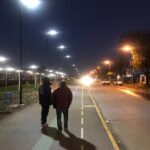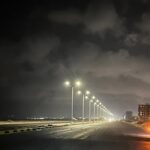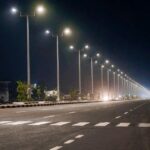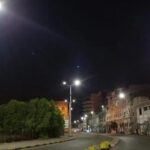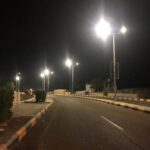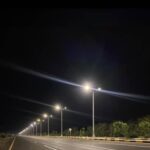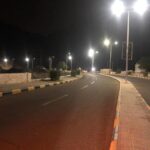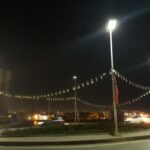In this day and age, the pervasive shift towards sustainable energy solutions has sparked a renewed interest in the cost dynamics of solar street lights. As urban landscapes evolve and prioritize eco-friendly alternatives, understanding the multifaceted factors influencing the cost of solar street lighting becomes paramount. A confluence of elements plays a pivotal role in shaping the economic landscape of harnessing solar energy for street illumination. Let’s dive in and explore some these factors.
Factors influencing the cost of solar street lights
What are the factors that influence the price of these light systems?
1. Quality of Components:
High-quality photovoltaic (PV) modules, commonly composed of monocrystalline or polycrystalline silicon cells, are paramount in ensuring optimal energy conversion rates. The efficiency of these modules, measured in terms of their ability to convert sunlight into electricity, directly correlates with the overall effectiveness of the solar street light system. Industry-standard silicon wafers, characterized by their purity and crystal structure, are indispensable in achieving maximum photoelectric conversion efficiency. Opting for a higher quality solar panel increases the cost of solar street lights.
The quality of energy storage components, typically lithium-ion batteries in contemporary solar street light systems, plays a pivotal role in determining the system’s energy autonomy and longevity. Cutting-edge battery technologies such as solid-state batteries, incorporating advanced materials and design principles, contribute to enhanced charge-discharge cycles, increased energy density, and improved overall reliability.
2. Light Fixture Type and Quality:
The choice of fixture type, such as LED (Light Emitting Diode) or traditional incandescent, directly impacts the efficiency, longevity, and cost of solar street lighting system. In solar street lights, LED fixtures are often preferred due to their higher luminous efficacy, which is the measure of how efficiently a light source produces visible light. LEDs are known for their efficiency in converting electrical energy into visible light, resulting in lower energy consumption and, consequently, reduced operational costs.
Moreover, the quality of the light fixture plays a pivotal role in the overall durability and performance of the solar street lights. High-quality fixtures are designed to withstand environmental elements, ensuring a longer lifespan and reduced maintenance costs. Additionally, fixtures with advanced features like smart controls and sensors contribute to energy optimization and further impact the overall cost of solar street lighting systems.
3. Lumens Output:
Luminous flux, expressed in lumens, represents the total quantity of visible light emitted by a light source per unit of time. In solar street lights, the luminous output correlates with the efficiency and brightness of the illumination provided. Solar street lights with higher lumen outputs generally incorporate more advanced and efficient light-emitting diodes (LEDs) or other light sources. These advanced technologies often come at a higher manufacturing cost. Moreover, the integration of sophisticated optics and thermal management systems to enhance luminous efficiency can further contribute to the overall cost of solar street lighting systems.
Higher lumen outputs are desirable in outdoor lighting applications, as they ensure better visibility and coverage, particularly in large areas such as streets or parking lots. However, it’s crucial to strike a balance between lumen output and energy efficiency to optimize the performance of the solar street light and, in the long run, minimize operational costs.
4. Pole Material and Design:
The choice of pole material is a critical determinant. High-quality materials such as galvanized steel or aluminum are often preferred due to their exceptional strength, durability, and resistance to corrosion. These materials ensure that the poles can withstand environmental challenges, including harsh weather conditions, without compromising their structural integrity over time. The material of the poles significantly impact the cost of solar street lights.
Moreover, the design of the poles is equally important in optimizing the efficiency of solar street lights. Scientifically engineered designs take into account factors such as wind resistance, load-bearing capacity, and ease of installation. A well-designed pole minimizes wind-induced vibrations, reducing the risk of structural fatigue and improving the overall stability of the solar street light system.
5. Installation and Labor Costs:
The installation process involves site preparation, including foundation work and positioning of the solar street light infrastructure. Knowledgeable labor is essential to correctly configure the solar panels to maximize sunlight absorption and adjust the angles for optimal energy capture. A cheaper installation process translates into an overall lower cost of solar street light systems.
Additionally, the connection of electrical components such as inverters, batteries, and LED fixtures demands precise expertise. Qualified personnel are necessary to ensure a seamless integration of these elements, promoting the smooth functioning and longevity of the solar street light system. Labor costs are integral factors influencing the overall cost of solar street lights.
6. Smart and Remote Monitoring Features:
Smart features play a pivotal role in shaping the cost of solar street lights. One key aspect is the integration of sensor technologies, such as photovoltaic sensors and motion sensors. These sensors enhance the solar street lights’ responsiveness by adjusting the light intensity based on ambient lighting conditions and human presence. The utilization of these sensors optimizes energy consumption, ensuring that the lights operate at their highest efficiency when needed and conserve energy during periods of low activity.
The incorporation of smart monitoring systems enables real-time data collection and analysis. This involves the use of Internet of Things (IoT) technology, which allows for seamless communication between individual solar street lights and a centralized control system. The integration of scientific principles, such as data analytics and machine learning algorithms, further enhances the efficiency of remote monitoring. These algorithms analyze historical data, weather patterns, and usage patterns to predict future energy demands and optimize the solar street lights’ performance accordingly. This predictive capability not only ensures consistent illumination but also contributes to a lower maintenance cost of solar street lighting systems.
7. Geographic Location:
The geographical location plays a pivotal role in determining the cost of solar street lights. In regions closer to the equator, where sunlight is more intense and consistent throughout the year, solar panels can efficiently convert sunlight into electricity, resulting in higher energy production. This optimal solar irradiance contributes to increased efficiency and performance of solar street lights, reducing the overall cost per unit of energy generated.
Conversely, in areas with higher latitudes or frequent cloud cover, the solar irradiance levels may be lower, affecting the efficiency of solar panels and necessitating larger, more expensive solar arrays to compensate for reduced energy production. Additionally, extreme weather conditions, such as excessive heat or cold, can impact the performance and longevity of solar components, influencing the overall system durability and maintenance cost of solar street lighting systems.
Moreover, the geographical location also affects the angle and orientation of solar panels, optimizing their exposure to sunlight. Adjusting these parameters based on latitude and local conditions can enhance the overall performance of the solar street lights.
8. Customization and Aesthetics
Customization significantly affects the cost of solar street lights. When tailoring solar lighting solutions to specific project requirements, various parameters must be considered, such as luminosity, battery capacity, and solar panel efficiency. Engineers meticulously design systems to match localized solar conditions, optimizing energy capture and storage. Moreover, customization extends to the choice of materials for durability and weather resistance. High-quality components, including corrosion-resistant metals and robust housing, contribute to increased longevity, but also escalate the overall cost.
The aesthetic appeal of solar street lights goes beyond mere visual harmony; it impacts functionality as well. Integrating aesthetically pleasing designs into urban landscapes requires advanced engineering. Materials must not only endure environmental stresses but also maintain their visual appeal over time. This often involves the use of specialized coatings and finishes. Aesthetically pleasing solar street lights may incorporate innovative designs to blend seamlessly with the surroundings. Furthermore, the integration of smart lighting controls for dynamic illumination based on ambient conditions adds a layer of sophistication, enhancing both functionality and visual appeal.
9. Warranty and Support
A robust warranty, characterized by extended coverage periods and comprehensive terms, is fundamental in securing the long-term investment in solar street lights. This warranty serves as a safeguard against unforeseen malfunctions and ensures that the photovoltaic (PV) panels, energy storage systems, and LED luminaires function seamlessly over an extended lifespan. A robust warranty translates into higher cost of solar street lighting systems.
Support mechanisms, including timely maintenance and technical assistance, actively contribute to the operational efficiency of solar street lights. Regular inspections, encompassing parameters such as solar panel cleanliness and battery health, are imperative to maximize the solar energy conversion efficiency. Scientifically driven preventive maintenance enhances the overall energy yield by minimizing losses due to factors like dust accumulation and module degradation. The active involvement of technical support in addressing potential issues, such as inverter malfunction or battery degradation, ensures the sustained performance of the light source. This proactive approach, grounded in scientific diagnostics and analysis, mitigates downtime and optimizes the overall cost of ownership.
Tips to remember when purchasing a solar street light
What should you look out for to ease the cost of solar street light systems?
- Ensure the solar panels are of high quality and have a sufficient capacity to generate energy for the light.
- Choose a solar street light with a battery that has adequate capacity to store energy for extended periods, especially during cloudy days.
- Opt for LED lights with high lumens to ensure sufficient brightness for the intended area.
- Confirm that the solar street light is designed to withstand various weather conditions, including rain, snow, and extreme temperatures.
- Consider lights with motion sensors and smart features to enhance energy efficiency.
- While keeping quality in mind, compare prices from different suppliers to find a cost-effective option.
- Ensure the product comes with a warranty to cover potential defects or malfunctions.
- Ensure that the solar street lights can be seamlessly integrated into existing infrastructure without causing disruptions.
Conclusion
Understanding the key factors influencing the cost of solar street lights is essential for making informed decisions in sustainable urban lighting projects. Do you need a solar street lights? Contact us.






